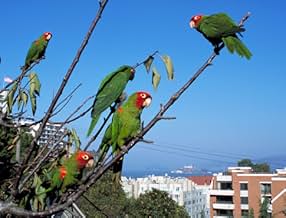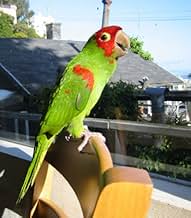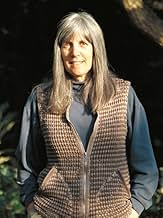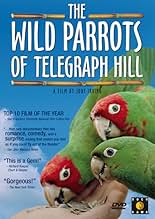IMDb-BEWERTUNG
7,8/10
3144
IHRE BEWERTUNG
Füge eine Handlung in deiner Sprache hinzuA homeless musician finds meaning to his life when he starts a friendship with dozens of parrots.A homeless musician finds meaning to his life when he starts a friendship with dozens of parrots.A homeless musician finds meaning to his life when he starts a friendship with dozens of parrots.
- Auszeichnungen
- 4 Gewinne & 2 Nominierungen insgesamt
Empfohlene Bewertungen
Days after seeing this film I am still moved by it. It is an understatement to say that this film left a lasting impression on me. Getting up close to the individual themselves, which all had such distinct personalities and stories, changed the way I look at birds, having always been somewhat afraid of them.
Mr. Bittner is an very intelligent man, deeply empathetic and self-aware. The way he handles his departure from Telegraph Hill is truly noble and self-sacrificing.
Highly recommended. Bring a tissue. The cinematography and photography is phenomenal - some impossible-seeming shots left my jaw on the floor. The the ending was a fantastic surprise!
Mr. Bittner is an very intelligent man, deeply empathetic and self-aware. The way he handles his departure from Telegraph Hill is truly noble and self-sacrificing.
Highly recommended. Bring a tissue. The cinematography and photography is phenomenal - some impossible-seeming shots left my jaw on the floor. The the ending was a fantastic surprise!
This is a little gem of a movie that deftly combines beautiful photography with an touching story line that gains depth as the movie progresses. The comic acting of the parrots and Mark Bittners amusing narrative keep the film from total chickflickness. Fun and touching, what more do you want. And, oh yeah, it's non-fiction. Great ending!
I guess the only film that comes to mind to compare it to is Winged Migration, a big hit film (for an indy) about birds. Parrots has some great footage of the birds in question, but none of that flying with the flock sensation thatt Winged had. But what Parrots has, of course, is humanity. The relation of Mark to the birds is central to the films arc. The film also addresses the issue of humanities impact on the environment and the natural vs unnatural setting for the parrots.
Ultimately it decides, and I agree, we've changed the environment of urban areas irretrievably so let's not pretend otherwise.
I guess the only film that comes to mind to compare it to is Winged Migration, a big hit film (for an indy) about birds. Parrots has some great footage of the birds in question, but none of that flying with the flock sensation thatt Winged had. But what Parrots has, of course, is humanity. The relation of Mark to the birds is central to the films arc. The film also addresses the issue of humanities impact on the environment and the natural vs unnatural setting for the parrots.
Ultimately it decides, and I agree, we've changed the environment of urban areas irretrievably so let's not pretend otherwise.
I just saw this on April 28, 2005, in the theater, and it was great! It was a last minute decision for us to go to the movies, and this was the first film to begin since we arrived, so we picked it, just for the heck of it. We had no idea what to expect, but both ended up loving it. I actually almost cried once, but I won't give away the moment.
It has a great message, regarding how many people view animals incorrectly, thus, treating them inhumanely sometimes, even when they think they are treating them great.
I was told by the Producer/Director/Editor, Judy Irving, that it won't be out on DVD until early 2006, after the theatrical distribution is over.
Here is the website for the film. You can email them to be added to a list, so you will be notified of when the DVD is available. But if you have the chance, I highly recommend seeing it in the theater. They deserve the money and recognition from the box office sales, plus, seeing it on the big screen is much nicer, IMO.
http://www.wildparrotsfilm.com/
It has a great message, regarding how many people view animals incorrectly, thus, treating them inhumanely sometimes, even when they think they are treating them great.
I was told by the Producer/Director/Editor, Judy Irving, that it won't be out on DVD until early 2006, after the theatrical distribution is over.
Here is the website for the film. You can email them to be added to a list, so you will be notified of when the DVD is available. But if you have the chance, I highly recommend seeing it in the theater. They deserve the money and recognition from the box office sales, plus, seeing it on the big screen is much nicer, IMO.
http://www.wildparrotsfilm.com/
It's a shame more people won't get to see this film. I find that documentaries such as this are increasingly becoming much more entertaining than the rehashed plots that Hollywood dishes out. The themes that even some of the best mainstream movies explore very well are that much more poignant and interesting when they're presented in real life. What's more, the plots in real life are often stranger and more fanciful. The relationship between Mark Bittner and this group of misplaced San Francisco parrots is amazingly deep and will touch your heart. Mark recognizes many of these birds by name and knows their personalities more thoroughly than most people know their friends. It's a wonderful piece of luck for all of us that a documentary film maker took the time to explore the life of a man and flock of animals that most people would never give a second thought. All the way through you care for the animals and Mark, and the ending is wonderful for mark and the film maker in a way that seems like it had to be dreamed up for Hollywood.
This film has a zen-like quality. It masterfully documents the bitter-sweetness of life with that magical aspect of wholeness and completeness that all great art embodies. It seemed effortless, honest, open. Clearly loving, sometimes painful, tragic, always beautiful, inspiring... Finely photographed and masterfully edited, this is an actively multi-dimensional film of transformation.
Attempting to compare this film is inappropriate, in my opinion. It stands alone and quite well on its own.
I noticed it was made in 2003, which would seem to indicate difficulty in getting distribution. If this hypothesis is true, I would consider it nothing less than a criminal indictment of the society in which we live.
To all the people who brought this film to me I send my warmest regards.
clay smith
Attempting to compare this film is inappropriate, in my opinion. It stands alone and quite well on its own.
I noticed it was made in 2003, which would seem to indicate difficulty in getting distribution. If this hypothesis is true, I would consider it nothing less than a criminal indictment of the society in which we live.
To all the people who brought this film to me I send my warmest regards.
clay smith
WUSSTEST DU SCHON:
- WissenswertesThe flock of wild parrots fly behind the red-tailed hawk in order to escape it.
- Zitate
Mark Bittner: We're all one river till we hit this cliff. That distance between the top of the cliff and the bottom of the cliff is our life. And all the individual little droplets think they really are individual little droplets until they hit the bottom, and then they're gone. But that droplet doesn't lose anything, it gains. It gains the rest of the river.
- Crazy CreditsShot on location -- no digital special effects.
- SoundtracksPeace of Mind
Performed by Mark Bittner
Top-Auswahl
Melde dich zum Bewerten an und greife auf die Watchlist für personalisierte Empfehlungen zu.
- How long is The Wild Parrots of Telegraph Hill?Powered by Alexa
Details
- Erscheinungsdatum
- Herkunftsland
- Offizielle Standorte
- Sprache
- Auch bekannt als
- Дикие попугаи с Телеграф Хилл
- Drehorte
- Produktionsfirma
- Weitere beteiligte Unternehmen bei IMDbPro anzeigen
Box Office
- Bruttoertrag in den USA und Kanada
- 3.058.527 $
- Eröffnungswochenende in den USA und in Kanada
- 36.731 $
- 13. Feb. 2005
- Weltweiter Bruttoertrag
- 3.219.179 $
- Laufzeit1 Stunde 23 Minuten
- Farbe
- Sound-Mix
- Seitenverhältnis
- 1.85 : 1
Zu dieser Seite beitragen
Bearbeitung vorschlagen oder fehlenden Inhalt hinzufügen

Oberste Lücke
By what name was The Wild Parrots of Telegraph Hill (2003) officially released in India in English?
Antwort












